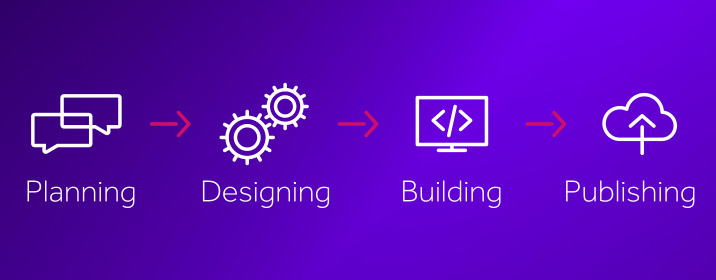Laying the foundations: planning your mobile app
Initiating the journey of mobile app development necessitates a robust groundwork, akin to constructing a building that demands a sturdy foundation. The initial phase is all about strategic planning, where your vision starts taking a structured form.
Embarking on this planning process requires a solid understanding of your business objectives so that you’re 100% clear how your new mobile app will fit into your overall business strategy. Specifically, what problem does it aim to solve? And who will benefit from it? These are pivotal questions and you need clear, agreed answers to these before you go any further.
Market research is important at this stage because it gives you insights into competitors’ strategies, user expectations and highlights any gaps in the current market that your app could potentially fill.
You should create a detailed blueprint for your project which shows the features, functionality and future roadmap for your app. This blueprint acts as a compass, guiding the project from concept to completion. It's important to factor in the technological requirements, budget constraints and timeframes to ensure a realistic and achievable plan.
In essence, the planning phase is about preparation and strategic foresight. It lays the foundation upon which the subsequent phases of app development - designing, building, and publishing - can happen. You need to spend sufficient time on this phase so ensure your planning is robust and complete because later phases of the app development project rely on clear, well-considered plan!

Crafting the user experience: designing your mobile app
This is the time when your app starts to take shape, both visually and functionally. The process turns previously abstract ideas into a tangible interface with which users will interact. This phase is not merely about aesthetics; it's about crafting an experience that feels intuitive and engaging for your end-user.
Engage with a skilled app designer / developer who understand the importance of marrying form with function, ensuring every tap, swipe and scroll is intuitive and enriches the user's experience.
Wireframes and prototypes are involved during this phase. They act as a visual blueprint, providing a framework of your app's layout and flow. This is where usability takes centre stage, focusing on creating a seamless navigation path that feels both natural and aligned with user expectations. The goal is to minimise friction, enabling users to achieve their objectives efficiently.
Attention to detail in the UI elements - such as button placement, colour schemes, and typography - plays a significant role in enhancing the UX. These elements should not only be visually appealing but also consistent and functional, contributing to a cohesive app environment. It's about creating an experience that resonates with your target audience.
Feedback is your friend at this point! Iterative testing with potential users can unveil insights and opportunities for refinement and enhancement.
You should not be too concerned if your developer has not worked on past projects in your industry.
Bringing your vision to life: building your mobile app
The journey of transforming your well-designed prototype into a tangible mobile app begins now. This stage is where the magic of coding brings to life the functionalities and features that have been so carefully plotted out. And the relationship between you and your developer is critical.
Ideally, your developer was involved during the design stage of your project, so they’re not getting involved now with no prior understanding of what you’re trying to achieve.
You do not need coding expertise to manage an app development project but an appreciation of the challenges facing your developer will stand you in good stead.
Unless your developer works with technology that enables them to create an iOS and Android version of your app from a single code base (or if you’ve decided that you only need an iOS app or a Android app and not both), you might be looking for two developers: one skilled in iOS app development and one in Android.
Choosing the right app developer
You should not be too concerned if your developer has not worked on past projects in your industry. Often, this isn’t especially relevant, particularly when compared to your developer’s core skills.
Instead, focus on asking your potential developer about how they will communicate progress and problems to you; how they will test your app and make it available to you for testing; what issues they foresee based on the designs you’ve already created; whether they will deliver the app in stages; and when they will invoice for their work.
Take a pragmatic approach: almost all development projects depart to some extent from the previously-agreed design! Unforeseen problems arise; people change their minds; technical issues sometimes force a change in plans; and feedback from prospective users can cause a shift in direction too.
For these reasons, timescales on app development projects can be difficult to pin down accurately.
Crossing the finish line: publishing your mobile app
When your app is ready for launch, you can submit it to the App Store (for your iOS app) or Google Play (for your Android app).
Both app stores are policed by gatekeepers who have the power to reject your app submission, particularly if it contravenes their published guidelines / standards or if it includes clear security issues.
This is such a critical moment in the overall project that you should familiarise yourself with the app store publishing standards at an early stage in the project or talk with your developer about the same, as they should have a good insight into what will / won’t get published.
When your app is published, consider whether it’s aimed at a private or public audience. Many business apps exist solely for use by employees, so a public listing in the app store isn’t necessary or appropriate in this instance.
For a public-facing app, spend time crafting an engaging and informative app store description and use a skilled designed to create eye-catching thumbnails, as these will attract interest from would-be users.
This is your opportunity to showcase the unique value your app brings, enticing them to download and explore its features.
Following launch, stay vigilant and monitor your app’s performance closely by gathering user feedback. The continuous loop of feedback-updates-feedback-updates is crucial for refining your app, enhancing its functionality, and ensuring it remains aligned with user needs and expectations. Launching your app is not the end; it’s the beginning of a journey of growth and evolution!
